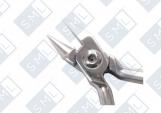Named for the Texas Study Club that first described it, this retainer has many special features worthy of consideration. The labial arch wire extends from molar to molar, ensuring excellent retention and control of the entire arch. Since it does not pass over the occlusal surface, there is no occlusal interference to prevent proper function.
To stabilize the labial, two small interproximal support wires pass from the acrylic and wrap around the arch wire between the cuspids and the laterals. (The extended arms to the cuspids to provide support and prevent rotation.)
Usually “C” Clasps are used distal of the twelve-year molar for appliance retention -- and are preferred in the interest of preventing any occlusal interference. Should retention pose a problem, it is advisable to place a small composite ledge on the molars. This creates a retentive undercut for the clasp.
Finally, a thin, heat-cured acrylic base is used for strength and comfort. During finishing, extra care must be taken to be sure that the acrylic is in contact with the entire lingual surface of each tooth.
Note: Always send the lab both upper and lower casts along with a bite relationship for fabrication of this appliance.









